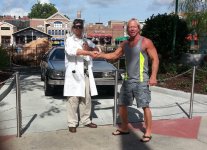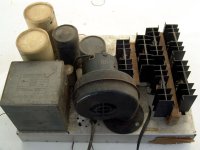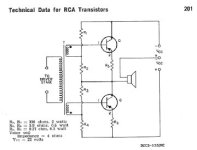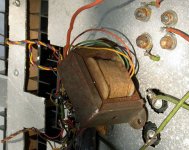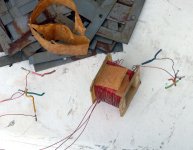You’re going to need a lot of 0.33 ohm 5 watt resistors. Hope Mouser has enough stock.
How much did you pay for the lot? Could be worth a fortune when OnSemi finally discontinues the 2N3055. Don’t think it can’t happen. ST did, recently.
Oh, they’ll still put it in a TO-247. But thats not a drop in.
How much did you pay for the lot? Could be worth a fortune when OnSemi finally discontinues the 2N3055. Don’t think it can’t happen. ST did, recently.
Oh, they’ll still put it in a TO-247. But thats not a drop in.
That many parts might just get you to 1.21 Jiggowatts with a little help from Marty Mc Fly and Doc Brown. I got the secret info from the man himself.....
Then I hopped into the DeLorean and went back to 1969 and built this with only 6 "2N3055's" I got from a similar looking bin at a surplus electronics store in Miami. Power output was measured at about 300 watts at an untold amount of THD with a very accurate for the time Simpson 260 meter. It did make for a killer guitar amp in true Marty McFly style. I still have some of those RCA branded house numbered parts......somewhere.
Then I hopped into the DeLorean and went back to 1969 and built this with only 6 "2N3055's" I got from a similar looking bin at a surplus electronics store in Miami. Power output was measured at about 300 watts at an untold amount of THD with a very accurate for the time Simpson 260 meter. It did make for a killer guitar amp in true Marty McFly style. I still have some of those RCA branded house numbered parts......somewhere.
Attachments
Glad you didn´t actually buy those, they are FAKEI was just kidding.
Just a picture I found on face book.
Have been offered them many times, been burnt a couple times, also found a couple inside amps returned for service, installed by unsuspecting local Techs.
The dead giveaway is the 3mm THICK steel base, instead of the usual 1.6 mm (1/16")
They are NOT using the mandatory copper "coin" heat spreader inside, they solder the transistor die straight to
steel 😱
Double thickness is useless since steel :
On average, the thermal conductivity of copper is 20 times that of stainless steel. In practical terms, this means that copper can transfer heat 20 times faster. So, if you need quick heating, copper will work to your advantage.
Heat Exchangers: Copper vs. Stainless Steel
What irks me is that the transistor chips/dies actually "work", often stand reasonable voltage, might pass some current, but since they can´t dissipate properly, they are useless for amplifiers.
Unless we are talking 15-20W ones that is.
I keep the ones brought as "replacements" by Customers only for very low grade jobs, generally as, say, 12V or 15V 1 or 2A (tops) regulated supplies, small battery chargers,etc.
Last edited:
Many of those thick bases were higher conductivity than steel - some were even copper. The thick base served as a heat spreader. Those packages were likely more expensive than the aluminum TO-3 Motorola would have been using at the time. Not necessarily better, but common in the early days.
55 watt would have been the 2N3054 (in a TO-66). It was only good for like 4 amps then beta hit the single digits.
55 watt would have been the 2N3054 (in a TO-66). It was only good for like 4 amps then beta hit the single digits.
I have managed to blow a few 2955/3055 pairs in my youth.
Me too.
The 60 volt (IIRC) Vceo of the 3055 limited the power into 8 ohms to about 40 watts before clipping. I think this is why the industry standard for speaker impedance changed from 16 ohms to 8 ohms. Anyway, there were amplifiers built with a whole lot more than 40 watt output. There are two ways this was accomplished.
1) Output transformer, which MacIntosh still uses to this day.
2) "Curve" a batch of 3055's and select the ones with higher Vceo. I'm sure I've seen schematics with 3055's running off of more than 60 volts.
A technician in the field would have to be aware of this. If you just stuck a random 3055 in a circuit like this then you might be screwing up. You had to measure the actual Vceo of the individual transistor to make sure you were OK.
I built an amplifier (a freebie) from an old Craig Power Play 8 track auto unit. It used germanium transistors driving output transformers. It delivered about 15 watts a channel off 12 volts. I ran it off 17 volts and it gave it more kick. The output stage had input transformers as well. What can I say? It worked pretty good. It sounded OK, maybe kind of "soft" in a tube amplifier sense. It was free and I was in high school.
Anyone remember the Tenna Ranger Mindblower amplified 6 X 9 inch speakers? Same concept.I built an amplifier (a freebie) from an old Craig Power Play 8 track auto unit. It used germanium transistors driving output transformers.
Most of the car radios of the late 50's and early 60's used either space charge tubes or germanium transistors for the actual radio reception circuitry but the final audio output stage used a single germanium TO-36 or TO-3 power transistor to drive the speaker in a class A SE design. I grabbed the radios from every junked car I came across to steal the transistors and OPTs. My DIY power source used a big Lionel train transformer, some diodes from a car alternator and a big fat cap. Most of the transistors would handle the train at full speed without blowing but only the strong could survive three 6 volt lantern batteries in series. None would eat 4 batteries. These experiments occurred back when I was in the 5th and 6th grade (10 or 11 years old).
I built the "2N3055" based amplifier seen in post #4 in my junior year of high school electronics class. It was 1968 or 69. It used a military surplus 75 volt 4.5 amp transformer into a 4 diode bridge for a bit over 100 volts of B+. I don't know what those transistors really were but none blew at that voltage. They were matched for similar collector current at a constant Vbe.
Sometime after high school (70 to 72) I found a monster heat sink in a military scrap yard that had 24 X Westinghouse 2N3773's and two fans on it. I used them in two banks of 12 and powered them by a means that cannot be discussed here. Isolation was provided by an input transformer, but the speaker jacks could be real shockers. We never knew how much power it made, because it could handle as many speaker cabinets as we connected. It was likely in the 1 KW range into a 2 ohm load. We drove it with a 50 watt Marshall guitar amp. The B+ was over 150 volts. I know that it happened before Dec 1972 because the scrapyard wad taken over by the NTSB after Eastern flight 401 crashed and closed to the public. All the plane wreckage was brought there to be analyzed.
Both amps used the totem pole circuit popular with 2N2147 transistors in the 60's. I used a single supply with a fat cap in series with the speaker. A trimpot across one of the bias resistors set the DC balance. Both driver transformers were DIY on the cores and plastic bobbins of Radio Shack filament transformers.......good enough for a LOUD guitar amp. The pictures show one of the transformers after 50 years in an outdoor shed.
Attachments
I remember the amplified 6x9s. I think there were a few brands. They were always at flea markets, always at Maxwell Street. https://en.wikipedia.org/wiki/Maxwell_Street
I could tell you some stories about Maxwell Street. It was a very exciting destination for a kid growing up in Chicago! It was taken over decades ago by UIC and they built dorms there.

I could tell you some stories about Maxwell Street. It was a very exciting destination for a kid growing up in Chicago! It was taken over decades ago by UIC and they built dorms there.
“By a means that cannot be discussed” - did you at least name it the “PTL” amplifier?
I did that once, but it was just six 2SD424’s, driven by 2N6547‘s out of a junked computer’s power supply (PDP11 comes to mind, something like that) and 2N3440/5415’s out of a dead Tektronics boat anchor scope. The 4000 uF/200V filter and output caps came from the same power supply. Front end was a souped up 15/25/40 watt classic Philips. Only needed 4 ohms per channel. Never was brave/stupid enough to gig with it - people were already nervous enough with our home-brew spaghetti-wired light boards.
I did that once, but it was just six 2SD424’s, driven by 2N6547‘s out of a junked computer’s power supply (PDP11 comes to mind, something like that) and 2N3440/5415’s out of a dead Tektronics boat anchor scope. The 4000 uF/200V filter and output caps came from the same power supply. Front end was a souped up 15/25/40 watt classic Philips. Only needed 4 ohms per channel. Never was brave/stupid enough to gig with it - people were already nervous enough with our home-brew spaghetti-wired light boards.
CDIL and BEL still make 3773s in India.
https://www.google.com/url?sa=t&rct...usg=AOvVaw0-BCKjtKNgr3qeS7NCpFYH&opi=89978449
https://www.google.com/url?sa=t&rct...usg=AOvVaw0-BCKjtKNgr3qeS7NCpFYH&opi=89978449
Good topic as well.home-brew spaghetti-wired light boards.
Sound and light work together well.
Very early on that was my electrical endeavors.
Since rather easy and " lamps" are accepted easy with no transformer.
So many coffee cans and lamps in the trash.
Become rather elaborate lighting systems.
Really blossomed in high school when I got almost endless colors from
school theatre gels. And actually made gel frames over coffee cans.
Very intense pinks and purples , colors people didnt see often.
Far as 2N3055 my first indestructible bass amp was a 2N3055 Quasi.
So no matter how people see quasi designs.
Or what I learned later on. Doesn't matter always love the things.
Sometime in the late 60's RCA brought out a line of transistors with weird numbers based on the 2N3055. There were a pair of complementary TO-5 drivers that came welded to square heat sinks, the 40409 and 40410, and the "mega3055" called the 40411. I believe that there was a predriver transistor often used in the diff pair front end, 40408 maybe. They published a "50 watt" quasi complementary amp circuit in the RCA Transistor Thyristor & Diode manual, SC-14 maybe. Instantly that circuit became the "standard design" for many HiFi and guitar amps.
All the Kustoms, some of the Acoustics, that horrible Fender PA amp that had no airflow and therefore blew up a lot, and even the big Heathkit guitar amp used exactly the same circuit. The Kustom K200 series (100 real watts) used two of the same circuits in parallel. Most were quite reliable.
All the Kustoms, some of the Acoustics, that horrible Fender PA amp that had no airflow and therefore blew up a lot, and even the big Heathkit guitar amp used exactly the same circuit. The Kustom K200 series (100 real watts) used two of the same circuits in parallel. Most were quite reliable.
My Acoustic 370 quasi had those big square plate drivers.
Seemed like magic science to me the first time I opened it.
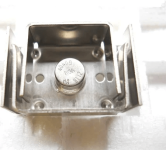
Beautiful transistors.
speed and thermal ratings higher than MJ packages
406 and 407 for small signal or differential
also in metal can.
from beginning to end could have all metal transistors.
just a wonderful little family
Seemed like magic science to me the first time I opened it.

Beautiful transistors.
speed and thermal ratings higher than MJ packages
406 and 407 for small signal or differential
also in metal can.
from beginning to end could have all metal transistors.
just a wonderful little family
- Home
- Member Areas
- The Lounge
- Bought some 2N3055S for my 1 mega watt power amp
